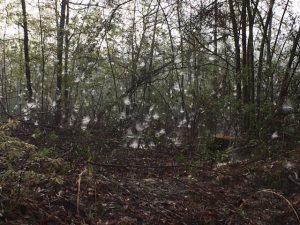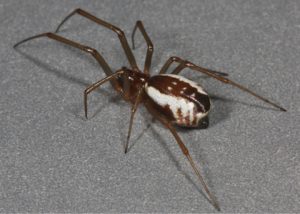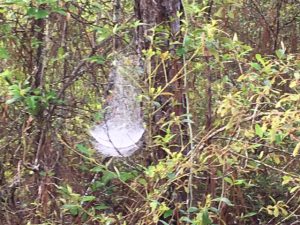With cool, foggy mornings you may have noticed the large number of spider webs hanging on low vegetation. Some of them have unusual shapes. One of the most notable is the bowl and doily spider. This spider (Frontinella pyramitela) is a species of sheet web weavers found throughout the United States, including Northwest Florida.
 It is a small spider, about 3-4 mm (0.16 in) long, boldly marked with black and white stripes on the abdomen, a brown cephalothorax, and brownish legs. They weave a fairly complex shaped webs only a few inches across, usually well off the ground and stretched between twigs or other objects. Webs consist of an inverted dome-shaped web, or “bowl”, suspended above a horizontal sheet web, or “doily”, hence its common name. The webs are approximately circular when viewed from above, where there is a tangled scaffold “knock down” threads of silk invisible to flying insects. The webs are commonly seen in weedy fields and in shrubs.
It is a small spider, about 3-4 mm (0.16 in) long, boldly marked with black and white stripes on the abdomen, a brown cephalothorax, and brownish legs. They weave a fairly complex shaped webs only a few inches across, usually well off the ground and stretched between twigs or other objects. Webs consist of an inverted dome-shaped web, or “bowl”, suspended above a horizontal sheet web, or “doily”, hence its common name. The webs are approximately circular when viewed from above, where there is a tangled scaffold “knock down” threads of silk invisible to flying insects. The webs are commonly seen in weedy fields and in shrubs.
Small flies, gnats and other small insects crash into the strands of barrier silk and fall down into the non-sticky webbing. The spider hangs from the underside of the “bowl”, and bites through the web, pulling the prey through in order to consume them while resting comfortably on the “doily”. Bowl and doily spiders serve a very important ecological role by controlling human-biting and plant damaging insects.
 Among web-building spiders, bowl and doily spiders (Frontinella pyramitela) are unusual because both males and females often cohabitate. The males rarely build webs, however, and so depend upon females ‘ snares for food. These cohabiting males capture about 32% of the prey that hit the web despite the female’s efforts to capture the same prey.
Among web-building spiders, bowl and doily spiders (Frontinella pyramitela) are unusual because both males and females often cohabitate. The males rarely build webs, however, and so depend upon females ‘ snares for food. These cohabiting males capture about 32% of the prey that hit the web despite the female’s efforts to capture the same prey.
Mating in this species occurs on the underside of the bowl of the female’s web and is preceded by a complex vibration- and chemical-mediated courtship during the late summer. Eggs are laid in silken sacs in the web or hiding in leaf litter on the ground. Both eggs and adults have been known to overwinter. Like all spiders, bowl and doily spiders develop through simple metamorphosis: spiderlings look like tiny adult spiders (but with lighter coloration), and shed their outer skin in order to grow. Most sheet web weavers live only one year.
- Watch for “Melting Grass” - February 19, 2025
- Palms Can Suffer in the Cold - January 30, 2025
- Camellia Care - January 9, 2025
